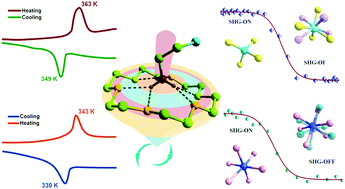Regulated molecular rotor in phase transition materials with switchable dielectric and SHG effect†
Abstract
The molecular machines are the smallest ideal model motor and won the 2016 Nobel Prize. They are famous for their unmatched performance and high availability in the fields of artificial micro-intelligence, storage and sensing, micro robots, precision medicine, biological manufacturing, etc. However, the physical and chemical mechanisms of motor motion at the micro scale are not completely clear, and the stability and controllability are both real challenges to be solved urgently. This hasgreatly hindered the progress and exploration of molecular motors. In view of this, we have designed a class of molecular machines that can be manipulated by heat or an electric field. This type of external field control is non-touching, non-destructive, energy-adjustable and structurally stable. Therefore, it is a completely random controllable molecular machine. The use of the macrocyclic crown ether phase transition materials we report here is a very feasible strategy to completely meet the above mentioned advantages. The two molecular motors, [(ClCH2CH2NH3)-(18-crown-6)][ClO4] (I) and [(ClCH2CH2NH3)-(18-crown-6)][PF6] (II), show dielectric and SHG (second harmonic generation) “ON” or “OFF” switching at 363 K and 343 K, respectively. Moreover, this presents an effective strategy for regulating the phase transition point (Tc) and SHG intensity with anions. In short, it is expected that this will open up new horizons for constructing switchable artificial molecular motors through phase transition materials.



 Please wait while we load your content...
Please wait while we load your content...